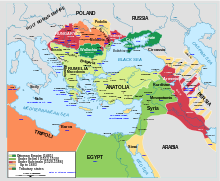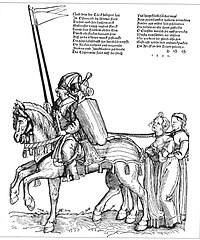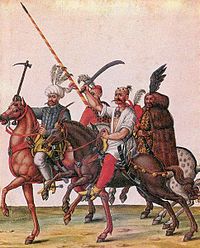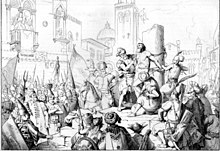Ottoman wars in Europe
| Military of the Ottoman Empire |
|---|
 |

A series of military conflicts between the
The
In the late seventeenth century, European powers began to consolidate against the Ottomans and formed the Holy League, reversing a number of Ottoman land gains during the Great Turkish War of 1683–99. Nevertheless, Ottoman armies were able to hold their own against their European rivals until the second half of the eighteenth century.[4][a]
In the nineteenth century the Ottomans were confronted with insurrection from their
History
Rise of the Ottomans (1299–1453)
Byzantine Empire
After striking a blow to the weakened Byzantine Empire in 1356 (or in 1358 – disputable due to a change in the Byzantine calendar), (see Süleyman Pasha) which provided it with Gallipoli as a basis for operations in Europe, the Ottoman Empire started its westward expansion into the European continent in the middle of the 14th century.
The remaining Greek states fell in 1461 (Despotate of the Morea and Empire of Trebizond) (see: Ottoman Greece).
Bulgarian Empire
In the latter half of the 14th century, the Ottoman Empire proceeded to advance north and west in the Balkans, completely subordinating Thrace and much of Macedonia after the Battle of Maritsa in 1371. Sofia fell in 1382, followed by the capital of the Second Bulgarian Empire Tarnovgrad in 1393, and the northwest remnants of the state after the Battle of Nicopolis in 1396.
Serbian Empire
A significant opponent of the Ottomans, the young
Crusades against the Ottoman Empire
As the Ottomans pressed westward, Sultan
Kingdom of Hungary

Since 1360s Hungary confronted with the Ottoman Empire. The Kingdom of Hungary led
In the year of 1442, John Hunyadi won four victories against the Ottomans, two of which were decisive.
The defeat in 1456 at the
During the reign of King
Growth (1453–1683)
Wars in Albania and Italy

The Ottomans took much of Albania in the 1385 Battle of Savra. The 1444 League of Lezhë briefly restored one part of Albania, until Ottomans captured complete territory of Albania after capture of Shkodër in 1479 and Durrës in 1501.
The Ottomans faced resistance from Albanians who gathered around their leader,

Conquest of Bosnia
The Ottoman Empire first reached Bosnia in 1388 where they were defeated by Bosnian forces in the
The
Croatia
After the fall of the
Conquest of Serbia
As a result of heavy losses inflicted by the Ottomans in the Battle of Maritsa in 1371, the Serbian Empire had dissolved into several principalities. In the Battle of Kosovo in 1389, Serbian forces were again annihilated. Throughout the 15th and 16th centuries, constant struggles took place between various Serbian kingdoms and the Ottoman Empire. The turning point was the fall of Constantinople to the Turks. In 1459, following the siege, the temporary Serbian capital of Smederevo fell. Zeta was overrun by 1499. Belgrade was the last major Balkan city to endure Ottoman forces. Serbs, Hungarians, and European crusaders defeated the Turkish army in the siege of Belgrade in 1456. After repelling Ottoman attacks for over 70 years, Belgrade finally fell in 1521, along with the greater part of the Kingdom of Hungary. The rebellion of Serbian military commander Jovan Nenad between 1526 and 1528 led to the proclamation of the Second Serbian Empire in modern-day Serbian province of Vojvodina, which was among the last Serbian territories to resist the Ottomans. The Serbian Despotate fell in 1459, thus marking the two-century-long Ottoman conquest of Serbian principalities.[20]
1463–1503: Wars with Venice
This section needs expansion. You can help by adding to it. (May 2008) |

The wars with the
1462–1483: Wallachian and Moldavian campaigns
In 1462, Mehmed II was driven back by
The Turkish advance was temporarily halted after Stephen the Great of Moldavia defeated the armies of the Ottoman Sultan Mehmed II at the Battle of Vaslui in 1475, one of the greatest defeats of the Ottoman Empire until that time. Stephen was defeated the next year at Războieni (Battle of Valea Albă), but the Ottomans had to retreat after they failed to take any significant castle (see siege of Neamț Citadel) as a plague started to spread in the Ottoman army. Stephen's search for European assistance against the Turks met with little success, even though he had "cut off the pagan's right-hand", as he put it in a letter.
1526–1566: Conquest of the Kingdom of Hungary


Since 1360s Hungary confronted with the Ottoman Empire. The Kingdom of Hungary led
After the Ottoman victory in the Battle of Mohács in 1526, only the southwestern part of the Kingdom of Hungary was actually conquered.[23] The Ottoman campaign continued between 1526 and 1556 with small campaigns and major summer invasions – troops would return south of the Balkan Mountains before winter. In 1529, they mounted their first major attack on the Austrian Habsburg monarchy, attempting to conquer the city of Vienna (siege of Vienna). In 1532, another attack on Vienna with 60,000 troops in the main army was held up by the small fort (800 defenders) of Kőszeg in western Hungary, fighting a suicidal battle.[24] The invading troops were held up until winter was close and the Habsburg Empire had assembled a force of 80,000 at Vienna. The Ottoman troops returned home through Styria, laying waste to the country.
In the meantime, in 1538, the Ottoman Empire invaded
In the major but moderately successful
The Ottoman Empire conducted another major war against the Habsburgs and their Hungarian territories between 1566 and 1568. The 1566 siege of Szigetvár, the third siege in which the fort was finally taken, but the aged Sultan died, deterring that year's push for Vienna.
1522–1573: Rhodes, Malta and the Holy League
This section needs expansion. You can help by adding to it. (May 2008) |
Ottoman forces invaded and captured the island of
After a siege of three months, the Ottoman army failed to control all of the Maltese forts. Delaying the Ottomans until bad weather conditions and the arrival of Sicilian reinforcements, made Ottoman commander Kızılahmedli Mustafa Pasha quit the siege. Around 22,000 to 48,000 Ottoman troops against 6,000 to 8,500 Maltese troops, the Ottomans failed to conquer Malta, sustaining more than 25,000 losses,
The Ottoman naval victories of this period were in the Battle of Preveza (1538) and the Battle of Djerba (1560).

The
1570–1571: Conquest of Cyprus
In the summer of 1570, the Turks struck again, but this time with a full-scale invasion rather than a raid. About 60,000 troops, including cavalry and artillery, under the command of Lala Mustafa Pasha landed unopposed near Limassol on July 2, 1570, and laid siege to Nicosia. In an orgy of victory on the day that the city fell—September 9, every public building and palace was looted. Word of the superior Ottoman numbers spread, and a few days later Mustafa took Kyrenia without having to fire a shot. Famagusta, however, resisted and put up a defense that lasted from September 1570 until August 1571.

The
In 1570, the
1593–1669: Austria, Venice and Wallachia
This section needs expansion. You can help by adding to it. (May 2008) |

- Long War(15-year war with Austria, 1593–1606) ends with status quo.
- Michael the Brave campaign against the Ottoman Empire (1593–1601)
- War with Venice 1645–1669 and the conquest of Crete (see Cretan War (1645–1669)).
- Austro-Turkish War (1663–1664): failed Ottoman attempt to defeat and invade Austria.
1620–1621: Poland-Lithuania

Wars fought over Moldavia. The Polish army advanced into Moldavia and was defeated in the
1657–1683 Conclusion of wars with Habsburgs
Transylvania, the Eastern part of the former Hungarian Kingdom, gained semi-independence in 1526, while paying tribute to the Ottoman Empire. In 1657, Transylvania under George II Rákóczi felt strong enough to attack the Tatars to the East (then the Empire's vassals), and later the Ottoman Empire itself, which had come to the Tatars' defence. The war lasted until 1662, ending in defeat for the Hungarians. The Western part of the Hungarian Kingdom (Partium) was annexed and placed under direct Ottoman control. At the same time, there was another campaign against Austria between 1663 and 1664. Despite being defeated in the Battle of Saint Gotthard on 1 August 1664 by Raimondo Montecuccoli, the Ottomans secured recognition of their conquest of Nové Zámky in the Peace of Vasvár with Austria, marking the greatest territorial extent of Ottoman rule in the former Hungarian Kingdom.[28]
1672–1676: Poland-Lithuania
The Polish–Ottoman War (1672–1676) ended with the Treaty of Żurawno, in which the Polish–Lithuanian Commonwealth ceded control of most of its Ukrainian territories to the empire. The war showed the increasing weakness and disorder of the Commonwealth, who by the second half of the 17th century had started its gradual decline that would culminate a century later with the partitions of Poland.
Stagnation (1683–1828)
1683–1699: Great Turkish War – Loss of Hungary and the Morea

The Great Turkish War started in 1683, with a grand invasion force of 140,000 men[29] marching on Vienna, supported by Protestant Hungarian noblemen rebelling against Habsburg rule. To stop the invasion, another Holy League was formed, composed of Austria and Poland (notably in the Battle of Vienna), Venetians and the Russian Empire, Vienna had been besieged by the Ottoman Empire for two months. The battle marked the first time the Polish–Lithuanian Commonwealth and the Holy Roman Empire had cooperated militarily against the Ottomans, and it is often seen as a turning point in history, after which "the Ottoman Turks ceased to be a menace to the Christian world".[30] [c] In the ensuing war that lasted until 1699, the Ottomans lost almost all of Hungary to the Holy Roman Emperor Leopold I.[30]
After winning the Battle of Vienna, the Holy League gained the upper hand and reconquered Hungary (Buda and Pest were retaken in 1686, the former under the command of a Swiss-born convert to Islam). At the same time, the Venetians launched an expedition into Greece, which conquered the Peloponnese. During the 1687 Venetian attack on the city of Athens (conquered by the Ottomans), the Ottomans turned the ancient Parthenon into an ammunitions storehouse. A Venetian mortar hit the Parthenon, detonating the Ottoman gunpowder stored inside, partially destroying it.[31][32]
The war ended with the Treaty of Karlowitz in 1699. Prince Eugene of Savoy first distinguished himself in 1683 and remained the most important Austrian commander until 1718.[33][34]
18th century
This section needs expansion. You can help by adding to it. (May 2008) |
The Fourth Russo-Turkish War took place in 1710–1711 in the basin of the Pruth river, as part of the Great Northern War. It was instigated by Charles XII of Sweden after the defeat at the Battle of Poltava, in order to tie down Russia with the Ottoman Empire and gain some breathing space in the increasingly unsuccessful campaign. The Russians were severely beaten but not annihilated, and after the Treaty of the Pruth was signed, the Ottoman Empire disengaged, allowing Russia to refocus its energies on the defeat of Sweden.
The Ottoman–Venetian War started in 1714. It overlapped with the Austro-Turkish War (1716–1718), in which Austria conquered the remaining areas of the former Hungarian Kingdom, ending with the Treaty of Passarowitz in 1718.
A war erupted again with Russia in 1735 and Austria in 1737. It lasted until 1739 when the Treaty of Belgrade was signed with Austria and the Treaty of Niš with Russia.
The Sixth Russo-Turkish War started in 1768 and ended in 1774 with the Treaty of Küçük Kaynarca. As a result of this treaty, the Crimean Khanate became a Russian client state.
Another war with Russia started in 1787 and a concurrent war with Austria followed in 1788; the Austrian war ended with the 1791 Treaty of Sistova, and the Russian war ended with the 1792 Treaty of Jassy.
An invasion of Egypt and Syria by Napoleon I of France took place in 1798–99, but ended due to British intervention.
Napoleon's capture of Malta on his way to Egypt resulted in the unusual alliance of Russia and the Ottomans resulting in a joint naval expedition to the Ionian Islands. Their successful capture of these islands led to the setting up of the Septinsular Republic.
19th century
This section needs expansion. You can help by adding to it. (May 2008) |

The First Serbian Uprising took place in 1804, followed by the Second Serbian Uprising in 1815. The result of this successful Serbian Revolution was the establishment of a semi-independent Principality of Serbia, and its acknowledgment by the Ottoman Empire (although de jure independent in domestic matters, the principality had to pay a yearly tax to the Porte and accept the permanent presence of the Ottoman army on its soil).
The
The
The Greek War of Independence started in 1821. The Great Powers intervened from 1827 in support of the revolutionaries, including Russia (Ninth Russo-Turkish War). The Treaty of Adrianople ended the war in 1829, and forced the Ottomans to accept Greek independence (as the new Kingdom of Greece), more autonomy for Serbia and the Russian occupation of the Romanian principalities.[35]
Ottoman decline (1828–1908)

The decline of the Ottoman Empire included the following conflicts.
Albanian rebellions 1820–1822, 1830–1835, 1847.
Bosnian rebellions 1831–1836, 1836–1837, 1841.
War with Montenegro 1852–1853.
The Tenth Russo-Turkish War of 1853–56, better known as the Crimean War, in which the United Kingdom and France joined the war on the side of the Ottoman Empire. Ended with the Treaty of Paris.
Second war with Montenegro in 1858–1859.
War with Montenegro, Bosnia and Serbia in 1862.
The decision to increase taxes to Christian nations in the empire's Balkan provinces resulted in widespread outrage that lead to several revolts. The first was the Herzegovinian Uprising in 1875, followed by Bulgarian revolutionaries starting an uprising in April 1876 that was brutally suppressed (see Batak massacre). Later in June, Serbia and Montenegro jointly declared war on the empire. After six months of inconclusive fighting, international reaction to atrocities committed by Turkish troops forced intervention of the major European powers, which concluded a ceasefire. In December, the Constantinople Conference was organized to deal with the situation and resolve the crisis. However, the Ottoman Empire refused the proposed reforms and withdrew from the Conference.
Russia, inspired by Pan-Slavism and feeling support in the anti-Ottoman sympathies running throughout Europe, saw the chance to declare war on the Ottoman Empire and fulfill the union of all Orthodox nations in the Balkans under its mantle. That started the eleventh Russo-Turkish War in 1877, fought in the Balkans and in the Caucasus, with Russia leading a coalition with Bulgaria, Romania, Serbia and Montenegro. The coalition won the war, pushing the Ottomans all the way back to the gates of Constantinople. Russians and Ottomans signed the Treaty of San Stefano in early 1878. After deliberations at the Congress of Berlin, which was attended by all the Great Powers of the time, the Treaty of Berlin (1878) provided independence or autonomy for the Christian nations in the empire's Balkan territories, and drastically restructured the map of the region.
Shortly after the war, Austria-Hungary was allowed to militarily occupy Bosnia, which formally continued to be part of the Ottoman territories.
Dissolution (1908–22)

This section needs expansion. You can help by adding to it. (May 2008) |
Italo-Turkish War
In 1911, Italy invaded Ottoman Tripolitania (During the colonisation of Africa, Tripolitania became Libya), which was controlled by the Ottoman Empire. The war ended with the Italian annexation of the Tripolitania.
Ilinden–Preobrazhenie Uprising
Bulgaro-Macedonian insurrection from 1903. See Ilinden–Preobrazhenie Uprising.
1912–13: Balkan Wars

Two
World War I
See also
Notes
- ^ The Ottomans were able largely to maintain military parity until taken by surprise both on land and at sea in the Russian war from 1768 to 1774. [5]
- ^ ...in Bosnia Jajce under Hungarian garrison held until 1527.[19]
- ^ The defeat of the Ottoman Army outside the gates of Vienna 300 years ago is usually regarded as the beginning of the decline of the Ottoman Empire. But Walter Leitsch asks whether it was such a turning point in the history of Europe? ... However, it marks a turning point: not only was further Ottoman advance on Christian territories stopped, but in the following war that lasted up to 1698 almost all of Hungary was reconquered by the army of Emperor Leopold I. From 1683 the Ottoman Turks ceased to be a menace to the Christian world. ... The battle of Vienna was a turning point in one further respect: the success was due to the co-operation between the troops of the Emperor, some Imperial princes and the Poles. ... However the co-operation between the two non-maritime neighbours of the Ottoman Empire in Europe, the Emperor and Poland, was something new. ... Walter Leitsch is Professor of East European History and Director of the Institute of East and Southeast European Research at the University of Vienna. [30]
Citations
- ^ Macfie (1996).
- ^ Stavrianos (1958).
- ^ Kakissis (2011), p. 224.
- ^ Aksan (2007), pp. 130–135.
- ^ Woodhead (2008), p. 983.
- ^ Tyerman 2019, p. 402.
- ^ a b Davies 1997, p. 448
- ^ Lock 2006, p. 200
- ^ Lock 2006, pp. 202–203
- ^ Davies 1997, pp. 544–545
- ^ Jefferson 2012, p. 278.
- ^ Jefferson 2012, p. 278–286.
- ^ Jefferson 2012, p. 286–292.
- ISBN 978-0-691-01078-6,
John Hunyadi accompanied by the cardinal-legate Giuliano Cesarini.
- ^ Jefferson 2012, p. 292.
- ^ The End of Europe's Middle Ages – Ottoman Turks.
- ^ Finkel (2004), p. 20.
- ^ a b Gavran (1990), pp. 39–44.
- ^ a b c Pinson (1996), p. 11.
- ^ a b Zidarić, Željko (2019-09-10). ... As Only True Men Can: Nikola Zrinski's Last Stand at Sziget. Željko Zidarić.
- ^ Cline (2019).
- ^ Pálffy, Géza (2001). "The Impact of the Ottoman Rule on Hungary" (PDF). Hungarian Studies Review (in Hungarian). 28 (1–2). Hungarian Studies Association of Canada, National Széchényi Library: 109–132.
- ^ The Battle of Mohacs, 1526 (2004).
- ^ Castles and History in Northern Transdanubia (2007).
- ^ Drégelypalánk (2021).
- ^ Smitha, 16th Century Timeline: 1501 to 1600 (2005).
- ^ Cassola (1999).
- ^ The Crusader Period.
- ^ 1683 Siege of Vienna.
- ^ a b c Leitsch (1983).
- ^ Tomkinson.
- ^ Mommsen (1941), pp. 544–556.
- ^ Habsburg-Ottoman War, 1683–1699 (2005).
- ^ Smitha, Ottoman Decline.
- ISBN 978-0521543231.
References
- Aksan, Virginia (2007). Ottoman Wars, 1700–1860: An Empire Besieged. Pearson Education Ltd. ISBN 978-0-582-30807-7.
- "The Crusader Period". All About All Crusades, A Chronological Time-table. Archived from the original on 21 October 2007. Retrieved 22 April 2021.
- "The Battle of Mohacs, 1526". World History at KMLA. Korean Minjok Leadership Academy. 17 November 2004.
- Cassola, Arnold (1999). The 1565 Great Siege of Malta and Hipólito Sans's La Maltea. Malta: Publishers Enterprise Group.
- "Castles and History in Northern Transdanubia". Archived from the original on 16 October 2007. Retrieved 22 April 2021.
- Cline, Austin (25 June 2019). "Expansion of the Ottoman Empire From 1300–1600". Learn Religions. Dotdash. Retrieved 22 April 2021.
- ISBN 978-0-7126-6633-6.
- "Drégelypalánk". IranyMagyarorszag!. 2021. Retrieved 22 April 2021.
- "The End of Europe's Middle Ages – Ottoman Turks". Archived from the original on 2013-09-03. Retrieved 2017-09-07.
- Finkel, Caroline (2004). Osman's Dream. Basic Books.
- Gavran, Fra Ignacije (5 October 2017). "Od zauzeća Bosne do podjele Provincije (1463–1514) – From the book "Suputnici bosanske povijesti", Svjetlo riječi, Sarajevo 1990". Bosna Srebrena (in Serbo-Croatian). Franciscan Province "Bosna Srebrena". Retrieved 2 February 2021.
- "Habsburg-Ottoman War, 1683–1699". World History at KMLA. Korean Minjok Leadership Academy. 13 July 2005.
- Kakissis, Joanna (2011). "Athens & the Islands". National Geographic Society.
- Leitsch, Walter (July 1983). "1683: The Siege of Vienna". History Today. 33 (7). Retrieved 19 December 2014.
- Lock, Peter (2006). Routledge Companion to the Crusades. ISBN 978-0-415-39312-6.
- Macfie, Alexander Lyon (1996). The Eastern Question 1774–1923 (2nd ed.). ISBN 978-1315841946.
- Mommsen, Theodor E. (1941). "The Venetians in Athens and the Destruction of the Parthenon in 1687". American Journal of Archaeology. 45, No. 4 (October–December 1941).
- Pinson, Mark (1996) [1993]. The Muslims of Bosnia-Herzegovina, the Historic Development from Middle Ages to the Dissolution of Yugoslavia (2nd ed.). United States: ISBN 0-932885-12-8. Retrieved 6 May 2012.
- "1683 Siege of Vienna". RateItAll. RateItAll, Inc. Archived from the original on 22 October 2007. Retrieved 22 April 2021.
- Smitha, Frank E. "Ottoman Decline". MacroHistory and World Report. Frank E. Smitha. Retrieved 22 April 2021.
- Smitha, Frank E. (2005). "16th Century Timeline: 1501 to 1600". MacroHistory and World Report. Frank E. Smitha. Archived from the original on 26 May 2008. Retrieved 22 April 2021.
- Stavrianos, L.S. (1958). The Balkans since 1453. NYU Press. ISBN 978-0814797662.
- Tomkinson, John L. Venetian Athens: Venetian Interlude (1684–1689). Anagnosis Books. Archived from the original on 30 June 2017. Retrieved 14 August 2012.
- Tyerman, Christopher (2019). The World of the Crusades. ISBN 978-0-300-21739-1.
- Urban, William L. (2006). "Baltic Crusades". In Murray, Alan V. (ed.). The Crusades: An Encyclopedia. Vol. I: A–C. ABC-CLIO. pp. 184–192. ISBN 978-1-57607-862-4.
- Woodhead, Christine (2008). "New Views on Ottoman History, 1453–1839". The English Historical Review. 123. Oxford University Press.
Further reading
- Anderson M.S. The Eastern Question 1774–1923: A Study in International Relations (1966) online
- Crawley, C.W. The Question of Greek Independence, 1821–1833 (1930). online
- Gerolymatos, André. The Balkan Wars (2008).
- Jefferson, John (2012). The Holy Wars of King Wladislas and Sultan Murad: The Ottoman-Christian Conflict from 1438–1444. ISBN 978-90-04-21904-5.
